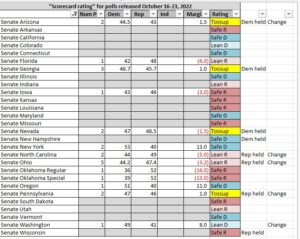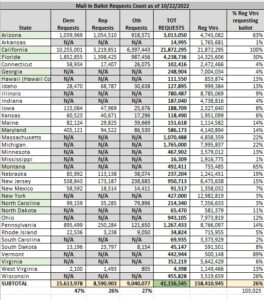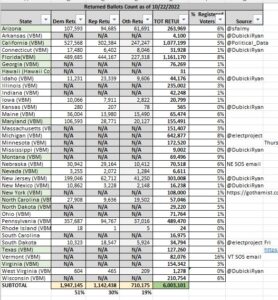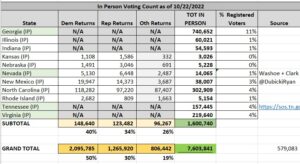America can now start to count down the 16 days until Election Day, as individual states are steadily coming online with early voting (early voting in Louisiana begins this Tuesday and lasts until November 1). We also have a steady volume of polling that we can use to make assessments on where races are heading – JMC will focus on Senate races today.
Scorecard Criteria
Publicly available polling data for all Senate races has been compiled for October 16-23 and with the availability of polling data since late August, we have some trends that can be determined across the country. As polling data is compiled for a given time period, it is then averaged for each Senate race, and with the average poll showing for each candidate, here’s how JMC rates each race:
(1) Safe Democratic/Republican – A candidate either has a polling average of at least 50% and/or at least a 10-point lead in the polls;
(2) Lean Democratic/Republican – A candidate has a 3–9-point lead in the polls;
(3) Tossup – A candidate’s lead is less than 3 points in the polls;
JMC’s 10/23 Scorecard
Given those criteria, this is the “state of the US Senate” as of the writing of this article (and based on October 16-23 polling data consisting of 24 individual Senate race polls):
Aggregate Dashboard statistics
- Biden job approval: 54-43% Disapprove (was 54-44% disapprove)
- Congressional job approval: 64-24% Disapprove (was 62-25% disapprove)
- Generic congressional vote: 47-45% Republican/Democratic (was 46.5-45.5% Republican)
- Direction of country: 68-26% wrong direction (was 68-28% wrong direction)
Senate race statistics
- Current: 50 Democrats, 50 Republicans
- Polling average: 49 Republicans, 47 Democrats, 4 Tossups (3 Democratic seats, 1 Republican seats) (was 49-47 Democratic in previous analysis)
- Net pickup: +0 (was +1 Democratic in previous analysis)
Commentary: Since the previous scorecard, there have been five ratings changes, all of which benefit the Republicans:
- Arizona: this is a race where Democratic incumbent Mark Kelly has seen his lead since August fluctuate between 4 and 6 points. In the past week, not only has the average of polling shown him with a 45-43% lead, but that has been a steady shift away from him since late September polling showing him up 48-42%. Therefore, we’re moving from “leans Democratic” to “Tossup.” Arizona is a strong early voting state, and 264,000 (6% of the electorate) have already voted;
- North Carolina: This open Republican held seat has bounced back and forth between a narrow lead for the Republican to a true tossup, but in the last week, polling conducted shows the Republican opening up a lead to where he now leads 49-44%. This is a steady improvement both from October 15 (when he led 43-42%) and September 30 (when he led 46-45%), Therefore, we’re moving from “Tossup” to “Leans Republican.” North Carolina is similarly an “early voting state”, and with in person early voting having started several days ago, 360,000 (5% of the electorate) have already voted;
- Ohio: This open Republican race has been in tossup territory for some time, but Republican nominee J.D. Vance has been steadily improving with each new scorecard. He first took a narrow 1-point (45-44%) lead in late September, which in mid-October became 2 points (46-44%) and is now (one week later) 47-44%, Enough for this race to be moved from “Tossup” to “Leans Republican.” While Ohio is fairly strong with early voting, ballots were only recently sent out, and therefore only 72,000 (1% of the electorate) have voted
- Pennsylvania: This open Republican race during the summer was viewed as a hopeless cause for Republicans, but Dr. Oz has been making steady gains since then. Until mid-September, he trailed by 7 points. That narrowed both in late September and early October to a 4-point deficit (44-48%) that in the last week has narrowed even more to a one-point (46-47%) gap. Therefore, we are moving this race from “leans Democratic” to “Tossup”. Furthermore, Pennsylvania does NOT have a tradition of early voting, but thanks to the pandemic, mail in voting was expanded, and 489,000 (6% of the electorate) have turned in their ballots so far. Could this voter bloc make a difference ? It all depends on how much the poll numbers can continue to shift, because that bloc of voters has been heavily Democratic;
- Washington: This seat has been held by Democrat Patty Murray since 1993 (and by Democrats in general since 1987), and in the August 2022 nonpartisan primary, the party vote for the Senate contest was 55-42% Democratic/Republican. Nevertheless, recent polling shows the race tightening a bit to 49-41% for Murray. Which fits the criteria for us to move from ‘Sage Democratic” to “Leans Democratic.” This is an 100% mail in voting state, and ballots were just sent out.
- There are two more Senate races on our radar, but data (or lack thereof) does not justify any ratings change at this point. In Georgia (a Democratic held seat), recent controversy involving the Republican nominee Herschel Walker only slightly dented him: in the last scorecard, he trailed 44-48%, and at the time, we didn’t think he was permanently damaged, so we kept at “Tossup.” Since then, our caution has been justified: Walker has narrowed the race again, to where he only trails 46-47%. New Hampshire is a case where there has been both a late (September 13) primary and scant polling, although we did see some narrowing of the race in this Democratic held seat the last time there was any polling conducted. From an early voting perspective, Georgia likes to early vote, and 817,000 (12% of the electorate) have already done so. New Hampshire is an Election Day voting state, and we don’t yet have any mail voting information.
Bottom line: there has been a “red breeze” that has picked up enough in the last week to where Republicans are more in the driver’s seat now with these Senate races than they have been in some time. However, there are still two weeks to go, and people are voting now.
Early voting
While Election Day isn’t until November 8, in person early voting has already started in 24 states, and will commence in 11 more states this upcoming week (Florida, Texas, and Wisconsin are the major ones). As of the writing of this article, here’s where we stand both with mail ballot requests, actual voted mail ballots, and in person early voting:
- Mail ballot requests : 41,156,545 (was 16,175,843 a week ago)
- Returned mail ballots: 6,003,101(was 1,917,506 a week ago)
- In Person Early Votes: 1,600,740 (was 165,549 a week ago)
In other words, at least 7.6M have already voted (early voting in Louisiana commences on Tuesday, October 25).
Why do these early voting numbers matter ? As mentioned in this analysis, 72% of the vote was cast before Election Day, and even considering that some of that was caused by the pandemic’s changing voting behavior (whether voluntarily or by government decree), JMC believes that there has been a permanent shift to some extent of people wanting to “get it over with” and vote before Election Day. This mindset WILL affect when people are making up their mind about who to vote for, and both candidates/consultants would be wise to take this new paradigm into consideration when planning their messaging/get out the vote efforts.
Conclusion
We’re beginning to enter the home stretch now. And poll numbers (and/or any trending) REALLY start to matter now.




